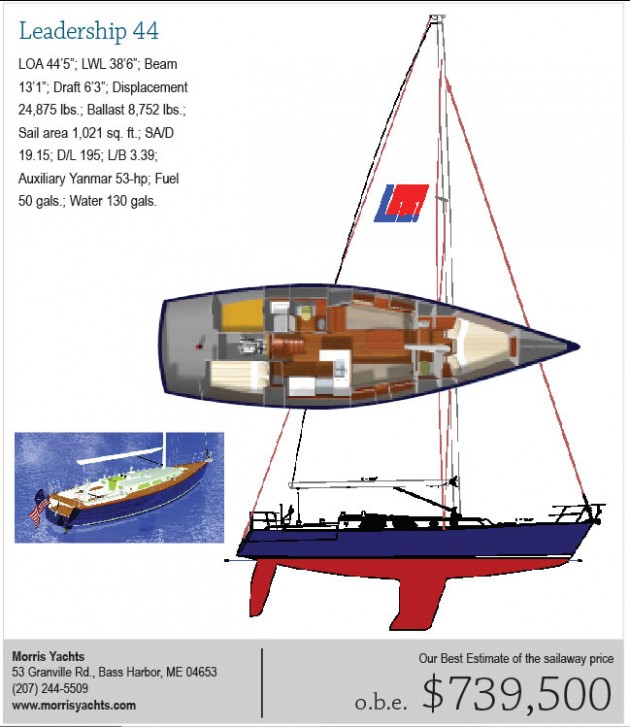Leadership 44
Training vessel/Bluewater cruiser
Dave Pedrick has been around the yacht design business for a long time. He began his career in the offices of Sparkman & Stephens and went on to establish his own office and is responsible for some marvelous designs. I can imagine that Dave was really happy to get the prestigious commission for the new 44-footers for the U.S. Coast Guard to replace its venerable Luders 44s. The result is a 44-footer that has two personalities. The initial version, the L44, was designed as a Coast Guard training vessel that would give midshipmen experience under sail in offshore racing conditions. The second version, the "Civilian model," is also available in two configurations, an Lc44 model for cruising and the Lp44 model for offshore racing. This is a very interesting design. The 44s will be built by Morris Yachts to the highest quality.
The D/L of this design is 195, using the "lightship" displacement, so it's not a light boat but you couldn't call it heavy either. It's moderate. The L/B is 3.39 and that is close to the middle of L/B spread. The hull sections show flare in the topsides, a bit of a slack bilge and no deadrise amidships. The rudder is a big, partially balanced spade type and draft is 8 feet, 8 inches with a bulb-tip on the keel. The stern is moderately broad. It's not a radical hull in any way but given its wide range of intended use this is probably a good thing. A shoal draft keel is in the works but I don't have a draft figure for it.
The Lc44 cruising layout features a V-berth double and a double quarterberth. The galley is well laid out in a U-configuration with a fore-and-aft leg to keep the cook from falling across the boat. There are two heads and the aft head has a shower stall. I like the long settees in the saloon and the port settee serves as the seat for the aft-facing nav station. The performance model has settee berths port and starboard with outboard pilot berths. There are folding upper and lower pipe berths forward and a single quarterberth aft. The galley is still large and well laid out and there is one large head aft. To my eye both layouts are very well done and should serve their respective purposes well. Headroom is 6 feet, 4 inches throughout.
The deck design shows wide side decks and a straightforward, nicely proportioned cabintrunk and a good, long foredeck. There is not a hint of Euro styling here. The cockpit is long and open at the transom. The removable helm seat spans the stern with what I think are life raft racks below the seat. The trim proportions of the cabintrunk allow for jib and genoa tracks to be well inboard. The chainplates are out at the rail. The mainsheet traveler spans the cockpit just forward of the large-diameter wheel. A large crew will be comfortable in this cockpit.
The fractional rig gives an SA/D of 19.15. This is modest by today's standards for a racing yacht but it's far from anemic. A conventional spinnaker pole will be carried on deck. Note the main roach just overlaps the backstay by about only 6 inches, so this will not be a problem tacking in light air. The spars are carbon by Hall Spars. Standing rigging is Navtec rod. Winches are Lewmar and headsail furling is Harken. Construction is composite, with infused vinylester resin over a balsa core-durability was a key issue. The auxiliary is a 53-horsepower Yanmar with a saildrive and a Flex-O-Fold prop.
I'm sure the midshipmen will enjoy being exposed to sailing with these new 44-footers. If history repeats itself the boat will see a lot of use and some of it will not be gentle. The civilian models should appeal to those looking for a very conventional, good all-around boat. Nice job, Dave.

Comments